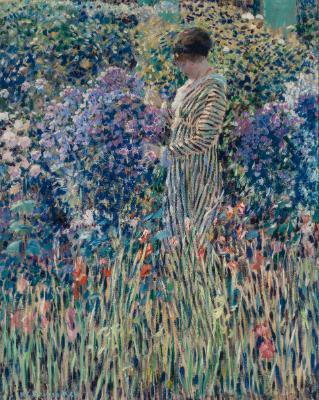Lady in a Garden
Item
-
Name
-
Lady in a Garden
-
Summary
-
The figure of a woman standing in profile seems visually overwhelmed and almost consumed in a riot of blossoms and leaves crowded into a luxuriant garden in Frederick Frieseke’s Lady in a Garden. The massed plants fill the composition to its edges, leaving only a glimpse, near the upper right corner, of two light-green shutters on the wall of a house. Spontaneous spots and dashes of thick pigment in pure color suggest a variety of plant forms and textures while creating an overall flickering effect to mimic the shimmering of the varied surfaces of flowers and foliage in brilliant sunlight. The woman’s striped dress seems a playful outgrowth of the dense tapestry of slender blades by which her lower body is completely screened.
The green shutters in the background suggest that Lady in a Garden, like many other outdoor works by Frieseke, may have been painted in the garden of Le Hameau, the house he occupied in the rural village of Giverny, France. Frieseke and his wife lived in the village every summer between 1906 and 1919, joining a lively artist's colony composed largely of American expatriates who painted using the divided brushstrokes, pure color, and bright light effects of impressionism as originally pioneered by Giverny’s most famous resident, painter Claude Monet (1840–1926). With the green-shuttered house in the background, their garden, avidly cultivated by Mrs. Frieseke, served as the setting for many other works, including the Breakfast in the Garden (TF 1987.21) and Lilies (TF 1999.55). While Mrs. Frieseke often modeled for these works, the identity of the woman in Lady in a Garden has not been confirmed. Her distinctive dress, however, appears in other paintings that verify that its bold stripes, here tinted pale green and lavender by reflections from the surrounding leaves and flowers, were simply black and white.
Frieseke often pictured the garden, like his interior settings, as the site of social and domestic activity, such as open-air meals and relaxed conversation. In other works, however, he concentrated on the formal possibilities and purely visual appeal of the female figure posed within a setting characterized by vivid contrasting pattern, whether provided by wallpaper, the fabric of clothing and upholstery, or, as here, garden foliage and flowers. With the figure nearly dissolved in the vivid mosaic of spots and dashes that describe her surroundings, Lady in a Garden takes Frieseke’s experimentation with purely decorative painting to its furthest extent. It incorporates the spontaneous painting technique and garden settings of impressionism and the emphasis on pure pattern, expressive color, and decorative design associated with the French painters known as Les Nabis (“the prophets”). (Source: Terra Foundation Collection Database)
-
Date
-
circa 1912
-
Dimensions
-
31 7/8 x 25 3/4 in. (81.0 x 65.4 cm)
-
Provenance
-
The artist
Macbeth Gallery, New York, New York, 1913
Mr. D. M. Ferry, Jr., 1924
Kay Kukes, Bloomfield Hills, Michigan
Berry-Hill Galleries, Inc., New York, New York
Daniel J. Terra Collection, Chicago, Illinois, 1982
Terra Foundation for the Arts Collection, Chicago, Illinois, 1999
-
Identifier
-
1999.52
-
Rights
-



